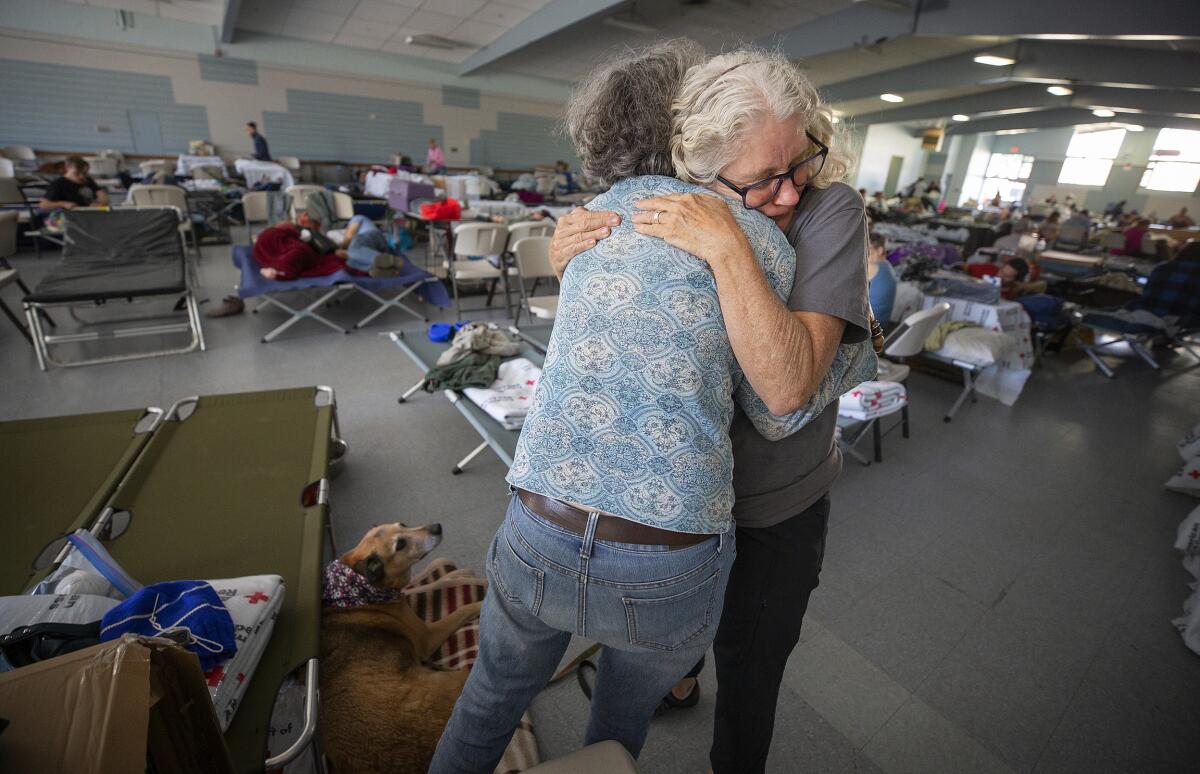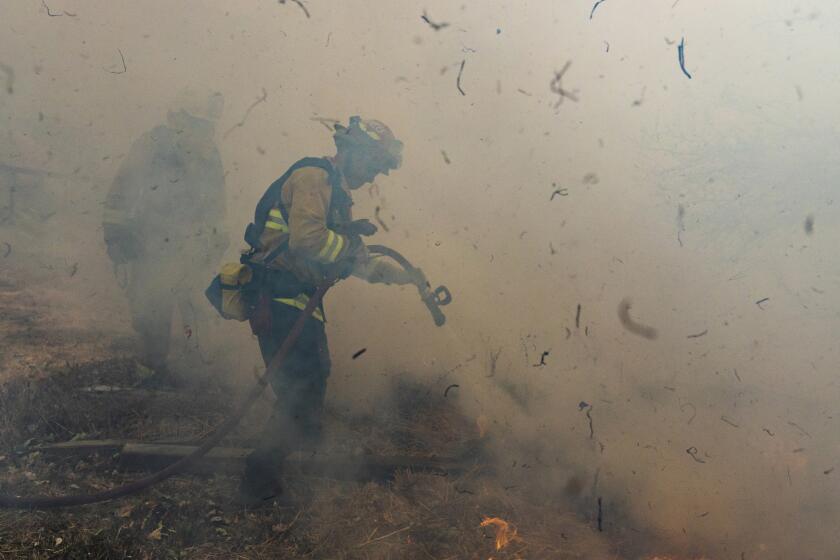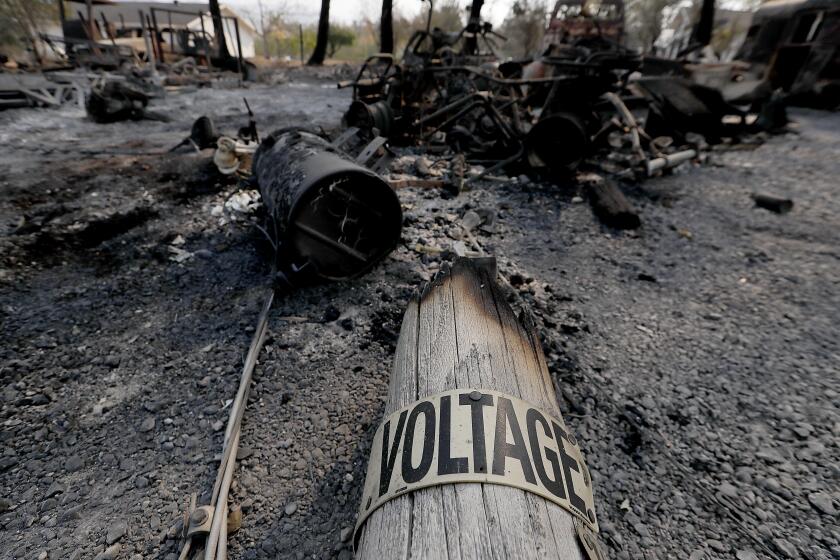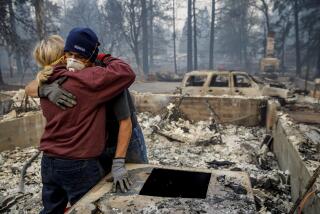Kincade fire creates 200,000 evacuees. ‘Who’s going to take them in?’

Roxane Stafford was talking really, really fast, as if she could outrun the raging Kincade fire with words alone. She worried that she sounded maybe a little bit crazy — her term — but that’s what disaster will do to you.
She and roommate DaNelle Ruth, their three dogs and one cat piled into their Honda CRV in Santa Rosa on Saturday morning, seeking safety from the latest blaze to lay waste to the California wine country. Two long days in transit, two nights in the car and 60 or so miles later, they found it.
On Cathedral Hill at an emergency shelter in the most crowded city on the West Coast, a place that sometimes feels as if it cannot hold another person. Where there’s a housing shortage and a vast population of homeless people and one of the highest hotel occupancy rates in the country during one of the busiest months of the year for the hospitality industry.
“We could see the fire coming. It looked like a rosy-colored fog bank. It came closer and closer,” Stafford said in a rush. “We went to three evacuations centers, and they were all full. ... I said, ‘The city is our best shot.’ ”
By Monday evening, the Kincade fire had forced nearly 200,000 people from their homes. And that’s not counting those who fled because of Pacific Gas & Electric Co. power outages. A quarter of the evacuation centers in Sonoma, Marin, Alameda and Napa counties were at capacity, a figure that changed depending on the hour.
Emergency shelters had been set up in churches and fairgrounds, community centers and community colleges. In Santa Rosa and San Rafael, Napa and Pleasanton. A memory care center in Petaluma opened its doors to evacuees from the fire but filled up fast.
Winds in Northern California are expected to peak again Tuesday evening. With gusts reaching 60 mph, PG&E says more shut-offs are possible.
Evacuees were left with a shrinking list of alternatives: friends and family members, hotels and motels, cold nights in their cars.
“Because of the vast number of people evacuating, where do you put them?” asked Jorge Rodriguez, a Sonoma County public information officer. “Who’s going to take them in?”
As of Monday at 8 a.m., when it first opened its doors, it was the Cathedral of Saint Mary of the Assumption, just north of the San Francisco Civic Center, perhaps the emergency shelter farthest from the Kincade fire. Traffic sped by. Tour buses discharged streams of visitors. The curious stopped to snap smartphone pictures of the imposing building.
And a stream of evacuees, lugging blankets and suitcases and children and pets, made their way in as Red Cross volunteers set up cots for the humans and members of San Francisco Animal Care and Control set up kennels and food and water bowls for their furry companions.
Julio Alvarado and his family of five left Santa Rosa at 4 a.m. on Sunday and headed south. Their apartment building is close to the small town of Windsor, where the fire was bearing down. Interstate 101 in the early-morning darkness was as bad as rush hour, stop and go, stop and go.
“I tried to sleep in Petaluma, but all the shelters was full,” he said. “I came to Marin and it was full. I came to San Francisco and stayed in a hotel. I pay for a small room, $157. I pay for just only one bed. It’s so expensive.”
Alvarado, a construction worker, and his wife, Ninfa, slept on the floor. Their three children got the bed. The Red Cross shelter in the cathedral was a huge relief.
“I don’t have the choice to pay another night,” he said. “It’s a lot of money.”
That was a common refrain for the working men and women of the North Bay who had to flee to pricey San Francisco and found shelter after shelter either full or, in some cases, closed because of fire danger.
The average daily hotel room rate in 2018 was $264.53, “the highest ever recorded,” according to San Francisco Travel, the visitors and convention bureau. In 2019, that figure is expected to rise almost 5%, to $276.66. That is, if you can find an empty room. Average occupancy rate is projected at 83.2% this year, and October is far from an average month. Through the 28th, occupancy this October is 90.6% for the city.
Even as howling winds calmed Monday, allowing firefighters to chip away at a massive fire in Sonoma County wine country, residents who fled their homes braced for more fear and uncertainty, while millions of others faced prolonged power outages.
On the plus side, Airbnb has activated its Open Homes program, a listing of members making space available to Kincade fire evacuees for free. And the Hotel Council of San Francisco has posted a list on its website.
Still, “spending money on a hotel is not a good thing,” said Antonio Ramirez, an animal technician at the Cotati Large Animal Hospital, who arrived at the cathedral shelter early Monday. “When I see this morning the news about this [place], I came right away.”
Ramirez, his wife, daughter and grandson fled their Windsor home Saturday afternoon. They spent the night with friends in Santa Rosa, but when that refuge was evacuated, they all had to leave. They’d heard that shelters in Sonoma County were either full or didn’t have power. They called a shelter in Marin County, but it was at capacity.
The group caravanned south to Novato. But there was no power in that city, either. That meant they couldn’t contact any hotels there even if the doors were open. So they ended up at a Lombard Street motel Sunday night — he and his family in one room, his friends and their smuggled-in pets in another.
“It’s really hard,” Ramirez said. “We want to be at home. I want to be at work.”
Around 10:30 a.m. Monday, DaNelle Ruth, 58, was chasing her terrier, Bizzi, around the parking lot of the cathedral shelter, trying to keep the little escapee from racing into traffic. A sheriff’s deputy joined the chase, then an animal control officer and a newspaper photographer.
Smoke from the Getty and Kincade fires are polluting the air in California’s two biggest cities, closing schools and adding to disruptions caused by blazes and power outages.
Stafford, 58, couldn’t take part in the pursuit. She has bone cancer, uses crutches and is waiting to have her right leg amputated above the knee. She has a 13-year-old service dog named Millai whom she can no longer care for but no one will adopt.
She and Ruth spent Saturday night in their car in a Santa Rosa strip mall parking lot with Bizzi, Millai, a Chihuahua named Minni Bell and a cat named Torti. The two women and four animals spent Sunday night in their car near a San Francisco motel where their friends had scored the very last room.
Finally, on Monday, they made their way to the cathedral shelter. There were cots for Stafford and Ruth. Kennels for Bizzi, who was finally apprehended, Minni Bell and Torti. Millai went off with an animal control officer, to be cared for until the group could return home.
“It’s hard for me but safer for her,” Stafford said. “If I didn’t have the animal control, I’d be in my car with her. No hotels take big dogs. And there are no hotels anyway. ... The animal shelter offering to board her is a godsend.”
By 6:30 p.m., about 40 people, five dogs and three cats were safely ensconced at the cathedral. It has room for about 200 people and two or three times the number of animals currently in residence. It is expected to stay open until Friday morning.
Stafford was curled up on a cot in the corner, wrapped in a bright patchwork quilt.
She was safe. At last. And she slept.
More to Read
Start your day right
Sign up for Essential California for news, features and recommendations from the L.A. Times and beyond in your inbox six days a week.
You may occasionally receive promotional content from the Los Angeles Times.










